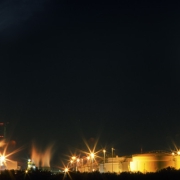There is a monster waiting for OPEC – and it’s not shale
So, OPEC has finally shown that they mean business and decided that they would reduce oil supply to prop up prices. I don’t want to belabor the futility of this gesture as I believe that no reduction any OPEC member would willingly abide by could change the fundamental oversupply situation oil finds itself in.
The world is drowning in oil and to add insult to injury, oil demand is growing only by anemic figures. The OECD world has used less oil every year for 10 years now if we can believe the statistics – it’s China and India plus other emerging economies playing catch up with the OECD that prop up the figures – for a little while longer.
I have already written about the conundrum OPEC and other conventional producers find themselves in. If they continue to flood the market they give shale the workout of its lifetime making it fit for even much lower oil prices which in turn bodes ill for OPEC’s aspirations. On the other side, if they cut supply and push prices a little higher they give shale drillers a shot of fresh cash in the arm and a renewed raison d’etre.
A little clarification – I am very liberal with the term OPEC here. What’s true for them also counts for many non-OPEC conventional producers of oil such as Russia but for simplification, I will hang with the term OPEC here.
Whatever way you like to see it – OPEC and the conventional producers look at the end of their glory days and the beginning of a very different time. A time when riches from oil are not automatic anymore just because there happens to be oil beyond those sands/ices/waters. It’s going to be a world where a real competitor puts a cap on whatever OPEC decides to give the world as a riddle.
But there is more to the bigger story – a beast is lurking in the shadows that is way more dangerous than shale oil. Shale – or tight oil as it’s more appropriately called – is just more oil that goes into straight competition with the oil OPEC produces. This means that those tight oil producers share the same economic environment as the conventional producers. If Brent goes up or down – the consequences of that movement are felt the same by both groups. The price goes up – cheers for both. Price goes down – hard times for both.
In Austria, we say that shared pain is only half the pain. To a certain extent, that’s true in oil. Partly at least.
However, oil does not live in a vacuum. There are other forms of energy competing with it. Natural Gas, coal, renewables, nuclear – you name it. Many of these energy forms don’t follow any movement oil makes so when the oil price changes, the game of incentives changes for the consumers as well. Oil is usually the fuel of last resort for power producers as in most cases they have better alternatives.
However, there was one domain that has lived in a state of quasi-monopoly by oil – this is transport.
Despite all the technological developments in e-mobility and other methods that are good for propelling a vehicle, the combustion engine using oil derivatives for fuel still comprises the vast majority of anything that moves anything. That’s true for naval vessels, airborne traffic as well as most traffic on and off roads. Locomotion constitutes the biggest market for crude oil and oil is the big dominator of this particular market. It has been a very strong and potent relationship so far and it still is.
Now however and for the first time, we can see a real alternative to oil derivatives making it into the big league. Natural Gas as a fuel makes a splash on the world stage. You must have been living on Mars if you have not noticed all the news in LNG bunkering developments. But even on the road, diesel is under heavy assault. Whole cities like Paris, Madrid, and Mexico City are planning to ban diesel cars and in certain German cities, they discussing diesel-free zones as well. The genie is out of the bottle and will not go back in.
For all the heavy transport, Natural Gas is the solution as this mode of transport has become more widely available today than only 5 years ago. Very few countries have no CNG fueling infrastructure and a good number of European countries have their very own LNG as a fuel scheme underway. North America is well on the way to becoming a fully covered market for those fuels as infrastructure there starts to reach out into the farther out bits of the continent. China is a hotbed of LNG vehicles and India is experimenting with the more exciting bits and pieces of gas as a fuel while there is an official policy that pushes those changes along.
All those developments have been there before the OPEC oil deal and will continue to develop their effects. Why should the OPEC deal or the wider behavior of conventional producers matter in this game?
Because for the first time, Natural Gas is more than an oddity in the vehicle fuels world. There is widespread consensus that diesel’s days are numbered and that it will not be part of the fuel mix at some point in the future anymore. There is also widespread consensus that the days of Heavy Fuels scorching the ocean’s skies must come to an end. Natural Gas is by no means the only alternative to those fuels but it’s by any measure the most economical and technically mature.
Natural Gas prices in the two biggest markets – North America and Europe – are largely not tied to the development of oil prices anymore. This means that OPEC’s decision is irrelevant to gas price developments in those two big and liquid markets. And as Europe is going to be the sink protecting the LNG world from its burgeoning oversupply, this price decoupling will filter through to LNG as well.
Asian customers of LNG are deeply unhappy with their long-term, destination-bound, oil price-linked contracts as they are much more expensive than alternative cargoes from the spot pool. They will wiggle quite a bit and judging from how this market is going to remain oversupplied for a fair number of years, this wiggling is likely to bear fruit. Prices in Asia will converge around the spot price indicators of the Atlantic basin eventually – don’t hold your breath just yet, though.
In the end, higher oil prices because of OPEC’s machinations coupled with relatively unchanged gas prices mean that the gulf between the cost of oil products and Natural Gas opens even more. Let’s just imagine that OPEC succeeds by pushing crude over 70 (that’s a stretch of the imagination by any standards) and gas prices stay where they are. Right now, the gulf between Natural Gas and Ultra Low Sulfur Diesel is about USD 10/MMBtu both in North America and in Europe. In Europe, it’s wider than ever. Natural Gas is just about one-third of the cost of diesel right now.
And every dollar OPEC and the conventional producers can squeeze out of crude oil buyers makes the pie more sexy for those looking at gasifying the transport fleet. OPEC is feeding a monster that will, one day, take it down. Tight oil in the US appears like a lesser worry compared to this.


















Dear Hubert. Good article. The world oil producers find themselves threatened by oversupply and supposedly weak demand. In fact, world demand of 96 million bbls/day is not to be sneezed at, although if we look at a century of oil prices, some of the bigger upswings (e.g. 1973) have since turned out to have been engineered. That is, the owners of Big Oil resort to all kinds of tricks to keep oil prices high. Russia says that their oil industry can sustain a price of $45/bbl. The 70 year post 1945 average oil price in 2013 dollar terms, is also about $45/bbl.
On the other hand, your article makes a good point that abundant LNG is about to change the way that surface transport fuels are used. To this, you could add electric trucks and buses, which are just now reaching mainstream useage. China’s 31 passenger BYD K9 electric bus is being manufactured in California and Bangkok; it can stay out on the road all day.
F William Engdahl argues that a century of high oil prices was largely engineered by oil companies. I.E. the stuff is cheaper and more abundant than we have been led to believe.
Thank you Evan, your last line sums it up very nicely. There is more oil and its cheaper than big oil wants us to think.